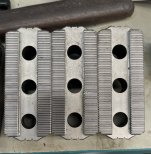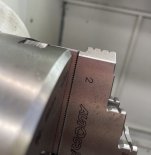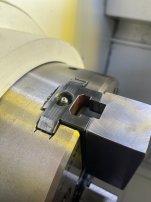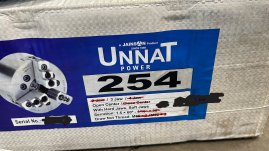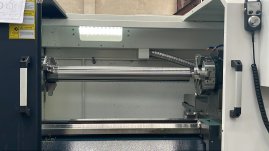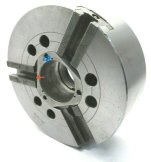1NoobMachinist1
Plastic
- Joined
- Oct 18, 2023
Firstly hello everyone, I'm pretty new to cnc machining and in dire need of advice as I am currently stumped with what to do any further, as the company I bought a 10" chuck from is insisting that my hard jaws are a problem.
Long story short, I bought a CNC machine roughly a year ago everything was going great until a horrible accident happened where I forgot to set one tool's offsets correctly up, in doing so once putting in a new stock piece for machining my turret ran unto my chuck at practically full speed, the result of this is that one of the master jaws had broken, forcing me to purchase a new chuck. What could cause this I checked the chuck itself while spinning and it only has +-0.01 mm runout, I also clamped a chrome chuck to show the runout experienced, its almost like there is a wobble even though all the hard jaws are correctly set (as shown in the photo, albeit attempting to place the hard jaws all level with the master jaw there is some slight discrepancy, 1 feels flush with the master jaw, the other 2 are either slightly protruding over the master jaw and the other slightly under the master jaw), I've uploaded some videos to this link (the website directs you to the temporary videos I've uploaded to WeTransfer), I also noticed that, the build quality of the master jaws don't look of high quality, I've counted the total gaps between the master jaw teeth and 2 of the master jaws had 50 "slots" and one had 49 I raised this and was told this has no matter, also as you can see in one of the photos one of the hard jaws one of the serrations are damaged which I ground out, but they insist that the runout is caused by that which I find to be impossible because of one serration being damaged? I am at a cross roads with this as the only way I could prove now that I do indeed suspect I've been sold a faulty chuck is by purchasing brand new hard jaws (which cost about $315), hence why I made this post to find out what else could be causing so much run out, any suggestions?
 we.tl
we.tl
Long story short, I bought a CNC machine roughly a year ago everything was going great until a horrible accident happened where I forgot to set one tool's offsets correctly up, in doing so once putting in a new stock piece for machining my turret ran unto my chuck at practically full speed, the result of this is that one of the master jaws had broken, forcing me to purchase a new chuck. What could cause this I checked the chuck itself while spinning and it only has +-0.01 mm runout, I also clamped a chrome chuck to show the runout experienced, its almost like there is a wobble even though all the hard jaws are correctly set (as shown in the photo, albeit attempting to place the hard jaws all level with the master jaw there is some slight discrepancy, 1 feels flush with the master jaw, the other 2 are either slightly protruding over the master jaw and the other slightly under the master jaw), I've uploaded some videos to this link (the website directs you to the temporary videos I've uploaded to WeTransfer), I also noticed that, the build quality of the master jaws don't look of high quality, I've counted the total gaps between the master jaw teeth and 2 of the master jaws had 50 "slots" and one had 49 I raised this and was told this has no matter, also as you can see in one of the photos one of the hard jaws one of the serrations are damaged which I ground out, but they insist that the runout is caused by that which I find to be impossible because of one serration being damaged? I am at a cross roads with this as the only way I could prove now that I do indeed suspect I've been sold a faulty chuck is by purchasing brand new hard jaws (which cost about $315), hence why I made this post to find out what else could be causing so much run out, any suggestions?
Untitled video - Made with Clipchamp (1).mp4
2 files sent via WeTransfer, the simplest way to send your files around the world


